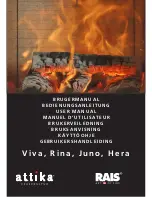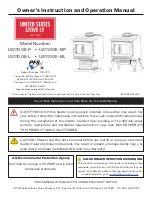
MIRIAM-NICE-DIANA-PRETTY-MARY
Pag. 71
3.
FUEL
3.1.
FUEL
Use only pellets. There are several types of pellets on sale with different grades. We recommend using
good grade pellets because they considerably affect the power and ash output. Characteristics of pellets
are: dimensions
6-7mm (Class D06), maximum length 40mm, power 5kwh/kg, humidity ≤ 10%, ash
residue ≤ 0,7%. They must be well pressed and not floury and completely devoid of residue from
adhesives, resins and other additives (we recommend pellets in accordance with EN14961-2 type ENplus-
A1). Unsuitable pellets cause bad combustion, frequent clogging of the burn pot and exhaust pipe,
increase consumption and lower heat output, dirty the glass, and increase the amount of ash and
unburnt granules. Attention: damp pellets cause bad combustion and operation of the stove, so make
sure they are stored in a dry place at least one metre away from the stove and/or any heat source. We
recommend trying several types of pellets on the market, choosing the one that performs the best. The
use of inferior grade pellets can damage the stove and annul the warranty and manufacturer’s liability.
Do not use the appliance as a waste incinerator. The use of pellets with characteristics different from
those described make it necessary to have a specialized engineer alter the operating parameters. All our
stoves are made with top quality materials such as stainless steel, cast iron, etc. Before being put on sale
they are tested in laboratories, however the components for pellet flow (auger) may have minimum
differences in the roughness-porosity of the material used which could generate natural variations in
movement of the fuel (pellets) causing the flame to rise or fall, and possibly go out at the lower powers.
We advise entrusting parameter setting to an authorized after-sales service.
4.
INSTALLATION
4.1.
FOREWORD
The assembly position must be chosen according to the space, exhaust pipe and flue. Check with your
local authority for any restrictions concerning combustion air inlets, room ventilation inlet, fumes
extraction, including the flue and chimney.
The manufacturer
declines all responsibility
if installation
does not comply with current law, air exchange in the room is not sufficient, electrical wiring does
not comply with standards and the stove is used inappropriately
. Installation must be carried out by
a qualified fitter who must issue the purchaser with a declaration of conformity. The fitter shall be fully
responsible for installation and the consequent correct operation of the stove. The stove is provided with
a manual for inspection and periodic maintenance to be carried out by the fitter, who shall make sure
there is a combustion air inlet and check for any other stoves or appliances that create draught in the
room (see
). When the stove is working, check that there is no CO in the room,
that the chimney has the necessary draught (see
), that fumes are evacuated safely (fume
leaks, distance from inflammable materials, etc.).
If the stovepipe passes through a wall made of a non-inflammable material, make a hole enlarged of
100mm minimum around the pipe; but if the wall is made of inflammable material, make a hole
enlarged of 300mm minimum around the pipe (see
For both cases, insert between flue and wall/slab a proper insulation.
We recommend to verify, with flue manufacturer, dimensions to respect for safety and the proper
typology of insulation to use.
Installation of the appliance must ensure easy access for cleaning the stove, exhaust pipes and flue.
It is
prohibited to install the stove in bedrooms, bathrooms, and fuel storage rooms
. If more than one
stove is installed the external air inlet must be of a suitable size (see
Summary of Contents for mary
Page 2: ...Pag 2 MIRIAM NICE DIANA PRETTY MARY Figura 1 Figura 2 ...
Page 33: ...MIRIAM NICE DIANA PRETTY MARY Pag 33 Image 1 Image 2 ...
Page 62: ...Pag 62 MIRIAM NICE DIANA PRETTY MARY Picture 1 Picture 2 ...
Page 91: ...MIRIAM NICE DIANA PRETTY MARY Pag 91 NOTES ...
Page 92: ...Pag 92 MIRIAM NICE DIANA PRETTY MARY NOTES ...
















































